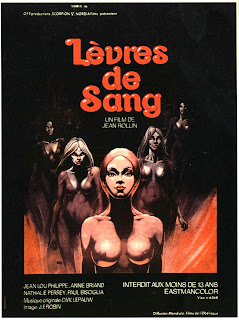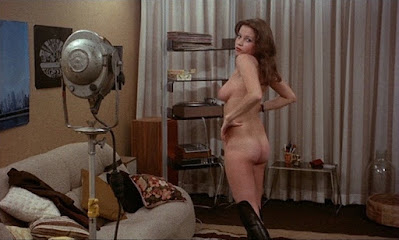Lips of Blood (Lèvres de sang), released in 1975, marks the end of the first phase of Jean Rollin’s career as a director. This was the period in which Rollin tried to combine unconventional erotic horror with full-blooded surrealism. It’s the most interesting phase of his career.
For a while it seemed as though the financial failure of Lips of Blood would more or less end his career and this his only future would be churning out adult movies. He had a rethink and then bounced back in 1978 with Grapes of Death, which began a much more overtly commercial period.
There were various reasons for Lips of Blood box-office failure. It appeared at a time when X-rated movies were all the rage in France and the softcore erotic horror of Rollin and similar film-makers was of little interest to distributors. The movie also had a very troubled production history, with Rollin forced to work with an unenthusiastic and unco-operative crew.
Rollin co-wrote the script with the film’s star Jean-Loup Philippe. Rollin considered it to be the best script he ever filmed. In retrospect Lips of Blood is one of his best movies, a dream-like poetic vision.
The movie starts with a prologue, with a body being put into a coffin which is sealed in a room. The body is shrouded but does not appear to be dead. The significance of this prologue will not become clear until late in the movie.
A young man, Frederick (Jean-Loup Philippe), sees a photograph of an old ruin. It triggers an odd disturbing poignant childhood memory. Or does it? Frederick is sure he has never seen this ruined chateau before, but the memory is so vivid. The truth is that there are gaps in Frederick’s memories of his childhood.
Perhaps if he can find the photographer he will be able to find the chateau. The photographer tells him that she has been paid a lot of money to keep that information from him. But, if he meets her at the Aquarium at midnight, she might tell him.
The meeting at the Aquarium is a beautifully shot scene and it begins the movie’s plunge into an increasingly dream-like mood. Frederick finds it difficult to distinguish between reality, illusion, dream and memory. The memories might be true, or they might be false.
He remembers a young girl at the chateau. He was wandering lost. He was twelve at the time. She was a teenager. He developed a crush on her, as 12-year-old boys are wont to do. But his mother is evasive when he asks her about the incident now.
After the meeting at the Aquarium Frederick is pursued by a man with a gun, the pursuit being a series of strange transitions of settings.
And then the vampire girls appear. Four vampire girls. Including the Castel twins, always a bonus in a Rollin vampire movie.
Rollin was always obsessed with the past and in this movie the hero has to unravel a mystery from his own past. He does eventually do so. We do get an explanation towards the end. And then the movie takes another turn into the fantastic and the surreal with a typically poetic Rollin ending.
Rollin was definitely a surrealist but you can’t appreciate his movies unless you know something about his other obsessions. One of these obsessions could be called vintage pop fiction. Rollin loved the feuilleton, the cheap sometimes trashy always breathlessly exciting serial stories that were so hugely popular in 19th century France. Rollin was no arid intellectual. He was an intellectual, but one with a taste for the pleasures of pop culture.
His vampire movies are horror movies, but don’t expect to be terrified or confronted by buckets of blood. Rollin liked vampires because he liked the idea of the past and the present being hopelessly intertwined and vampires by their nature exist outside of time. Time has no meaning to a vampire. And Rollin also liked vampires because they were mysterious and romantic and poetic. If you compare this movie to vampire movies made by other European directors at the time, such as Jess Franco’s Female Vampire and Jose Larraz’s Vampyres (both great movies) it’s obvious that Rollin approached vampires in a very different way.
This is a movie about searching. Searching for the past, for memories, for identity, for meaning, for love. It’s both melancholy and strangely romantic.
This certainly qualifies as erotic horror. There’s an amount of female frontal nudity. But it’s part of the texture of the movie - Frederick’s memories are amalgams of lost love and eroticism. The vampires in this film are not particularly scary or evil but they are very erotic. From the time that the vampire first appeared in European literature (in Coleridge’s poem Christabel in 1797) eroticism was implicit in vampirism. Vampires symbolise both life and death and eroticism is the key to life.
The Redemption Blu-Ray offers a lovely transfer. Extras include a very brief introduction by Rollin, an informative interview with his frequent collaborator Natalie Perrey and excellent liner notes by Tim Lucas.
Lips of Blood is Rollin at his best. Very highly reommended.





1 comment:
Great review. Definitely agree with Lips of Blood being one of Rollin’s best films.
Fingers crossed for Indicator releasing a 4K of it this year.
Post a Comment